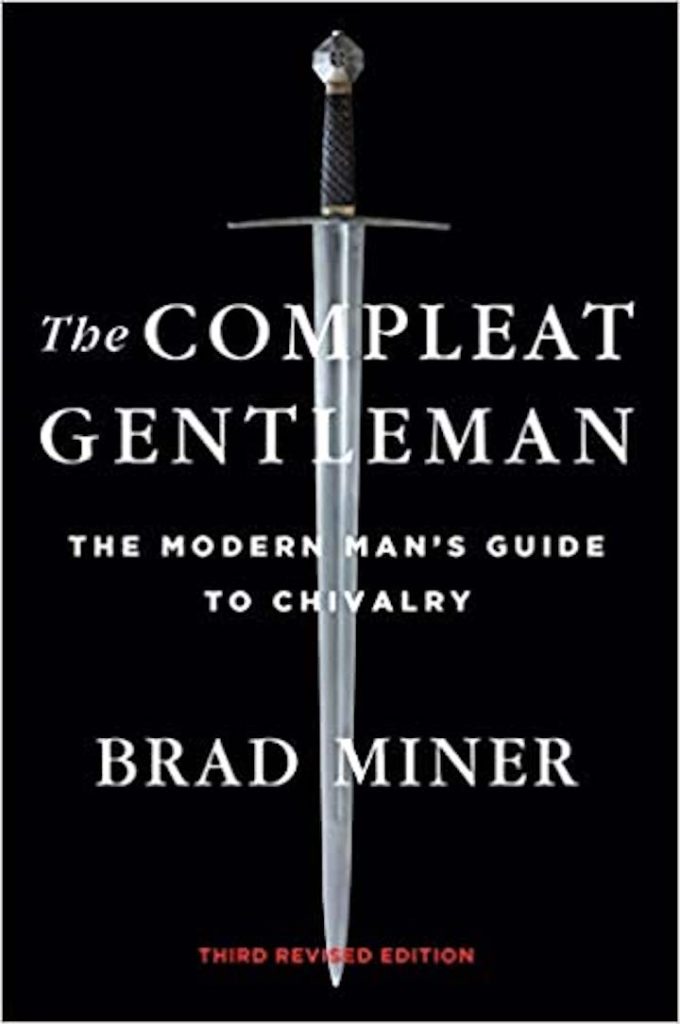We are verbose creatures. Humanity’s gift of language includes our gift of creating languages. But despite a surfeit of vocabulary, our terms often fail to adequately describe what we mean. Definitions slip. Meanings change. But not the underlying reality, to which we were trying to point. We keep circling round it with new words, few of them ever really hitting the mark.
Take the word “gentleman.” My family has a long and complicated history with that term. It was wielded with both frequency and specificity. And yet, it has often left me baffled and uneasy. For I am, despite an uncommon upbringing, a thoroughly modern woman.
And it’s as a woman that I wish to share some reflections on the third edition of Brad Miner’s The Compleat Gentleman: The Modern Man’s Guide to Chivalry.
When I hear the term “gentleman” many competing images come to mind, some of which are flattering, others decidedly not. Add to that the word “chivalry” and the effect is force-multiplied.
We have all met those who have been designated (by themselves or others) as gentlemen who are poor representatives of the genre. The fakers, the players, the cads. Those who are weak and hide behind the term as an excuse for not taking a stand or for employing misplaced diplomacy.
And we have met rougher men who are unmoneyed and unschooled, but have a moral code still worthy of the title.
But are any of them gentlemen, properly speaking? Is there a reality behind a term which, circling round its target, is always seemingly shy of the mark? Is it manners? Bloodlines? Wealth? A moral code? And more importantly: is it even relevant to ask the question in the modern world?
Miner explores each of these issues and answers the last question with a resounding: Yes. I completely concur. Now, more than ever, we must ask ourselves who we are as men and women and what motivates our actions and culture, which is disintegrating before our eyes.
I say the question is relevant for the modern world because things do not simply fall apart when challenged. They fall apart because no one defends them. And that is symptomatic of a far greater problem.
I found The Compleat Gentleman to be, unexpectedly, a “compleat” history of the term. More than that, it’s a chronicle of the ideas and ideals that undergird such a designation. This was a happy surprise. Far from being just a manual of how to be a gentleman, Miner’s book wrestles with the ugly parts of its background and the way in which it’s been viewed differently across time.
He uses three archetypes to accomplish this: the warrior, the lover, and (perhaps a surprise for some readers) the monk.
There are figures in its pages who will anger, repel, and annoy you. There are also personages (sometimes much-maligned) who will surprise you with their grace.
And this is what I find to be the book’s truest strength. Does Miner have decided ideas about what makes a gentleman? Certainly. But it is the fair exposure of the good, the bad, and the ugly – which allows a person to engage the book and think for themselves.
And that was the second unanticipated virtue of his work. I’m a quick reader. A couple hundred pages is an evening’s class prep. But this book took me a while to get through. Not because it’s a difficult read. It is not. But because I found myself taking notes. I stopped and thought things over. I argued with him. I argued with myself. Only later did I appreciate my notepad full of things to look into, books to read later (more than 200 works are cited in the bibliography), and connections to explore.
This is precisely what a book should make all of us do: think. It would be a different world if today’s cancel culture took a moment to examine why they agree or disagree with others; if they engaged and learned something in the process rather than creating a very undiverse echo chamber.

Why do I bring this up? Because I suspect there are individuals who will take exception to some of the things he says. Some will likely struggle with the idea of a gentleman needing to be not merely strong but even “dangerous.” It gave me pause too, if only because I was struck by the frankness of what is so rarely admitted these days.
But if you push away a book claiming a gentleman is dangerous and aware of his capacity for violence, you will be missing an important truth. Strong and dangerous cannot be equated with unstable and brutish criminality. They are not the same. But today, we view ‘dangerous’ as unpredictable. Ergo we build safe rooms for those not given adequate trigger warnings or who unexpectedly come up against a soul who believes differently than they do.
Feelings are feelings. But they have become the barometer by which we judge safety and danger. I do not believe Miner’s claim is in error.
As a fully revised and updated edition, Miner’s book has no shortage of surprisingly current and contentious topics that we are all struggling with these days. And what I just said about engaging a book and thinking it through applies to these areas as well.
He treats everything from transgenderism in sports to women in the military, from Antifa and BLM to January’s riot at the U.S. Capitol. His final chapter on sprezzatura even ventures into restraint and circumspection – which I think are antidotes for our gross overexposure on the internet and in real life. Do not come with preconceived notions about what his take on things will be. You may be surprised. And this is found especially in his belief that a gentleman’s stance towards women should always be to give them what they desire.
Many may view this as a book for men. Fair enough. But men and women rise and fall together. I encourage the thinking woman to spend some time with it.
















